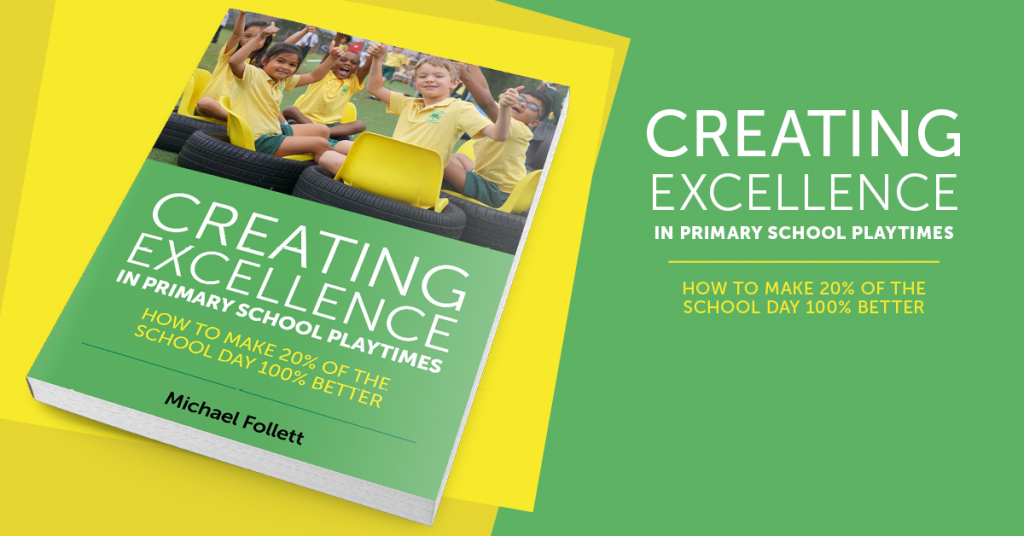 Michael Follett, author of Creating Excellence in Primary School Playtimes, provides 10 tips to help primary schools meet Ofsted criteria for excellent playtimes.
Michael Follett, author of Creating Excellence in Primary School Playtimes, provides 10 tips to help primary schools meet Ofsted criteria for excellent playtimes.
Imagine childhood without play. It sounds unthinkable but for around 50% of UK children school playtimes are the only time they get to play freely in an open space with their friends. When you think that out of 7 years at primary school, 1.4 of those years is time for play, it is clear that schools are ideally placed to enable children to access 180 days a year of great play opportunities.
As a former teacher, playworker and school improvement adviser I have dedicated the past 17 years to helping schools understand how to improve playtimes. It’s a great project as everyone wins, children are happier and healthier, teachers get more teaching time, leaders more leading time and playtime staff a much more satisfying job. So here are my top ten tips, condensed from my work developing the OPAL Primary Programme with over 200 schools in three continents.
1. Change your culture – A school that values play is a school that understands that play is essential to children’s physical and mental wellbeing and that the recipe for play requires some dirt, some risk, plenty of choices, quite a lot of freedom and a growing amount of trust. Once your school develops a culture of valuing play and understanding the simple conditions it requires to grow and flourish the rest is relatively easy.
2. Use what you have – OPAL’s research has revealed that the average primary school uses its field for between 8-16% of the 180 days there are in the school year. If you have space, don’t spend money on equipment until you find ways to use your valuable space for at least 80% of the year. (OPAL School’s average around 95%).
3. Put someone in charge – Good play in a school takes planning, resources and persistence. 20% of the school day will not improve itself. Traditionally schools dedicate very little leadership attention to the management of what is often the trickiest part of the school day to manage.
4. Be Generous – How many children are in your school – 100, 200, maybe 500? How many hours play is that a year? In a school of 200 children the answer is 160,000 play hours a year. So be generous – don’t build one play house build ten, don’t put in a sand table, build a beach! Children need lots of space and lots of stuff to avoid conflict at playtimes and access to plenty of fuel for their imaginations.
5. Make use of free stuff – Children much prefer to play with stuff than on things. They don’t really mind what you give them to play with, they just need lots of it. So don’t worry about asking the PTA to raise thousands to build a thing to play on, instead think about how you can provide children with many, many things to play with. We are not talking about toys, we are talking about the secret magic ingredients of play called loose parts, which is virtually anything you can think of that is safe enough to play with, from and empty box to an old pan or a bit of wood.
6. Use Nature – Nature changes every day, it re-grows, it is naturally calming and attractive to children. Instead of a play catalogue why not go to a garden centre and see what resources they have that would provide lots of open ended play value?
7. Provide Choices – What is the essence of play? It is surely the freedom to choose for yourself. To be able to decide for your own reasons and motivations where you go, who you play with and what you play with. Look around your playground. Is it an oasis of potential choices waiting to be discovered? The more variety on offer, the more freedom of choice actually means something.
8. Allow time – Play is a human right under the UN Convention on the Rights of the Child Article 31 and every school has a legal and moral duty to implement the convention. So don’t regard playtime as a problem to be whittled away or used up with finishing work, but as an opportunity to provide an essential part of a good childhood.
9. Don’t waste your money – Children will always be attracted by newness, so any play equipment, however poor its play value, will be investigated by children for the first six weeks of its presence, but children are around school play equipment for around 1800 hours a year, for several years and it is only worth investing in capital equipment which will continue to present interest and challenge, building strength, fitness and coordination over a number of years, otherwise you are just buying very expensive benches to hang-out on.
10. Keep it up – Providing great play for every child should be the concern of every adult who cares about quality of childhood, because making play better in schools is not up to children, it is up to us the decision makers and power holders, the leaders, staff and parents. We are the people who are in charge; of their time, and their space, and the rules. Governments are not, and children cannot make us provide for their play, it must be done because we ourselves care about children having fun, joy and happiness.
If you would like to read more articles like Michael’s and get the latest news and offers on our education books, why not join our mailing list? We can send information by email or post as you prefer. You may also be interested in liking our Special Education, PSHE and Early Years Resources Facebook page.